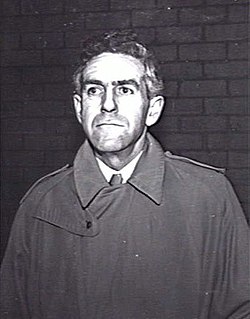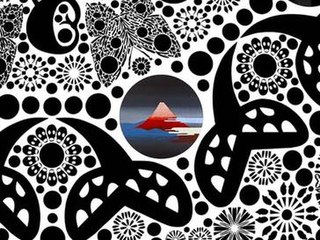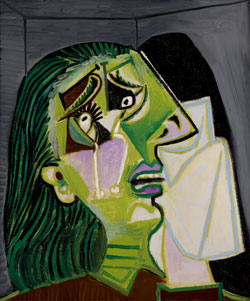
The Turner Prize, named after the English painter J. M. W. Turner, is an annual prize presented to a British visual artist. Between 1991 and 2016, only artists under the age of 50 were eligible. Awarding the prize is organised by the Tate gallery and usually staged at Tate Britain, though in recent years the award ceremony has sometimes been held in other UK cities. Since its beginnings in 1984 it has become the UK's most publicised art award. The award represents all media.

Milton Ernest "Robert" Rauschenberg was an American painter and graphic artist whose early works anticipated the Pop art movement. Rauschenberg is well known for his Combines (1954–1964), a group of artworks which incorporated everyday objects as art materials and which blurred the distinctions between painting and sculpture. Rauschenberg was both a painter and a sculptor, but he also worked with photography, printmaking, papermaking and performance.
Australian art is any art made in or about Australia, or by Australians overseas, from prehistoric times to the present. This includes Aboriginal, Colonial, Landscape, Atelier, early-twentieth-century painters, print makers, photographers, and sculptors influenced by European modernism, Contemporary art. The visual arts have a long history in Australia, with evidence of Aboriginal art dating back at least 30,000 years. Australia has produced many notable artists of both Western and Indigenous Australian schools, including the late-19th-century Heidelberg School plein air painters, the Antipodeans, the Central Australian Hermannsburg School watercolourists, the Western Desert Art Movement and coeval examples of well-known High modernism and Postmodern art.

Katherine Linn Sage, usually known as Kay Sage, was an American Surrealist artist and poet active between 1936 and 1963. A member of the Golden Age and Post-War periods of Surrealism, she is mostly recognized for her artistic works, which typically contain themes of an architectural nature.

Captain Sir William Alexander Dargie was a renowned Australian painter, known especially for his portrait paintings. He won the Archibald Prize, Australia's premier award for portrait artists on eight separate occasions; a record held since 1952.

Robert Lyall "Alfie" Hannaford, is an Australian realist artist notable for his drawings, paintings, portraits and sculptures. He is a great-great-great-grandson of Susannah Hannaford.

Ernest William Buckmaster (1897–1968) was an Australian artist born in Victoria. He won the Archibald Prize in 1932 with a portrait of Sir William Irvine. He also served as an Australian war artist during World War II.
Godwin Bradbeer is a New Zealand-born artist now living and working in Melbourne, Australia. Bradbeer is known for large-scale figurative drawing and has been exhibited internationally since the 1970s. He has taught at the University of Melbourne, the Victorian College of the Arts, Monash University, and other art schools in Australia and Asia. From 2005 to 2010, he was head of drawing of the School of Art at RMIT University in Melbourne.
The Bay Area Figurative Movement was a mid-20th Century art movement made up of a group of artists in the San Francisco Bay Area who abandoned working in the prevailing style of Abstract Expressionism in favor of a return to figuration in painting during the 1950s and onward into the 1960s. Spanning two decades, this art movement is often broken down into three groups, or generations: the First Generation, the Bridge Generation, and the Second Generation.

Shane William Cotton is a New Zealand painter whose work explores biculturalism, colonialism, cultural identity, Maori spirituality, and life and death.

Chua Ek Kay was a Singaporean artist hailed as the "bridge between Asian and Western art" with a unique painting style using Chinese ink on paper that demonstrated an ingenious blend of traditional Chinese painting forms with Western art theories and techniques. Most of his works were themed of Chinatown street scenes, lotuses, and abstract works inspired by Australian aboriginal cave paintings.

Gareth Sansom is an Australian artist, painter, printmaker and collagist and winner of the 2008 John McCaughey Memorial Prize of $100,000.

Sunday in the Park with George is a musical with music and lyrics by Stephen Sondheim and book by James Lapine. It was inspired by the French pointillist painter Georges Seurat's painting A Sunday Afternoon on the Island of La Grande Jatte. The plot revolves around George, a fictionalized version of Seurat, who immerses himself deeply in painting his masterpiece, and his great-grandson, a conflicted and cynical contemporary artist. The Broadway production opened in 1984.
Arthur Fortescue McKay, best known as Art McKay was a Canadian painter and a member of The Regina Five. Many of his works are modernist abstractions.
Contemporary Indigenous Australian art is the modern art work produced by Indigenous Australians, that is, Aboriginal Australians and Torres Strait Islander people. It is generally regarded as beginning in 1971 with a painting movement that started at Papunya, northwest of Alice Springs, Northern Territory, involving Aboriginal artists such as Clifford Possum Tjapaltjarri and Kaapa Tjampitjinpa, and facilitated by white Australian teacher and art worker Geoffrey Bardon. The movement spawned widespread interest across rural and remote Aboriginal Australia in creating art, while contemporary Indigenous art of a different nature also emerged in urban centres; together they have become central to Australian art. Indigenous art centres have fostered the emergence of the contemporary art movement, and as of 2010 were estimated to represent over 5000 artists, mostly in Australia's north and west.

Chris Heaphy is a New Zealand artist who is based in Auckland. His work explores cultural issues with a greater focus on the relationship between Maori and Pakeha due to the artist's background.
Witness Kay Chiromo was a Malawian artist and art educator. He was born in Makoka Village, T.A. Chigaru, Blantyre District. He is considered as one of the most talented and respected artists from Malawi. His medium was oil paintings but he also carried out book illustrations and made a video documentary.

The theft of The Weeping Woman from the National Gallery of Victoria took place on 2 August 1986 in Melbourne, Australia. The stolen work was one of a series of paintings by Pablo Picasso all known as The Weeping Woman and had been purchased by the National Gallery of Victoria for A$1.6 million in 1985—at the time the highest price paid by an Australian art gallery for an artwork. A group calling itself "Australian Cultural Terrorists" claimed responsibility, making a number of demands in letters to the then Victorian Minister for the Arts, Race Mathews. The demands included increases to funding for the arts; threats were made that the painting would be destroyed. After an anonymous tip-off to police, the painting was found undamaged in a locker at Spencer Street station on 19 August 1986. The theft still remains unsolved.

Nahem Shoa is a contemporary London painter best known for his series of portraits, collectively called Giant Heads, which were painted at up to 15 times life size. He is also notable for having increased the number of portraits of Black and mixed-race British people on display in British museums. Shoa has won a number of awards and prizes for his work, and serves on The Royal Albert Memorial Museum and Art Gallery's Contemporary Arts Panel. His work has been exhibited in London's National Portrait Gallery and the Royal Academy as well as at galleries and museums in other parts of the UK.

Desmond W. Helmore is a New Zealand artist and illustrator, known both for his fine art and for his scientific work depicting insects, not least illustrating the New Zealand Arthropod Collection. One of the country's most noted and prolific biological illustrators, over 1000 of his illustrations of insects were published in research papers from 1976 to 2006.
















